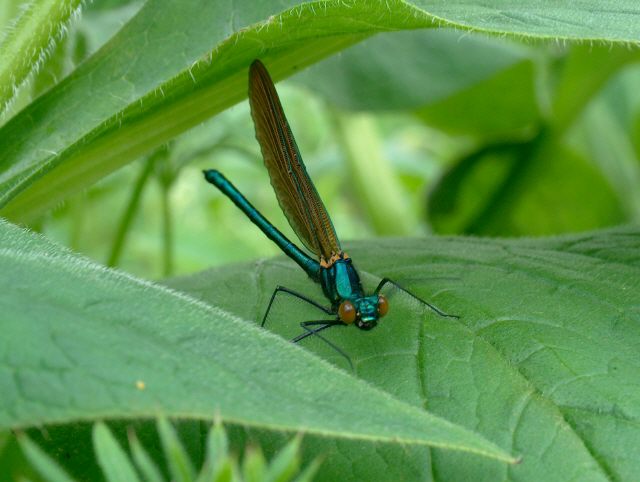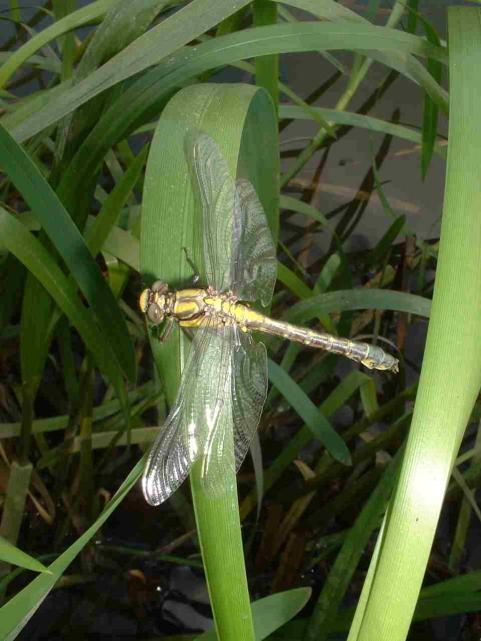|
||||||||||||||||||||||||||||||||||||||||||||||||||||||||||||||||||||||||||||||||||||
Warwickshire Dragonfly Group - News archive25th
November
Records of this year's late flying dragonflies 17th
August 2004
More on Small Red-eyed Damselflies.
27th December
2003
22nd June 2003 14th June 2003 9th June 2003 7th June 2003 1st June/31st May 2003 31st May 2003 30th May 2003 24th May 2003 19th May 2003 14th May 2003 11th May 2003 8th May 2003 5th May 2003 22nd April 2003 12th January 2003 15th July
2002
3rd July 2002 15th June 2002 8th June 2002 1st & 4th June 2002 New species of damselfly in Warwickshire!!!!! 31st May 2002 19th May 2002 18th May 2002 17th May 2002 11th May 2002 10th May 2002 4th May 2002 24th April 2002 23rd April 2002 14th April 2002 10th February 2002 Now the weather has turned cold for several days we have probably
seen the last flying dragonfly of 2005. Until the middle of November it
remained quite warm and we have had some late sightings. The latest
sightings for Migrant Hawker Aeshna mixta and Common Darter Sympetrum striolatum held in the
county records before this year were 3rd and 6th of November
respectively. As the records received so far for this November show,
those dates have been pushed on significantly:
Back to page top.
The spread of the Small Red-eyed
Damselfly continues. Graham Rowling spotted one individual at
Brandon Marsh on Goose Pool on Sunday 21st August. Kay and Peter
visited one of our country houses, Arbury Hall, Nuneaton on Sunday 28th
August and found at least ten ovipositing pairs and ten or more
individual males on an area of semi-submerged vegetation. All the
individuals seen were in a quite local area of one of the garden ponds
close to the house. On another pond, that looked very suitable habitat,
about 50 metres away from the hot spot there was no sign of SREDs. Where else are they? If you see any anywhere in Warwickshire (VC38),
please let us know. We have been visiting a number of sites trying to see were the Small Red-eyed
Damselfly is getting to. Yesterday, 18th August, we found one male
at Wormleighton Reservoir among about a dozen Red-eyed Damselflies. This
is unusual compared with the other sites in the county were several
individuals were found together. Also, the vegetation was not typical
of other sites, no semi-submerged plants but floating warter lily pads
(perfect for Large Red-eyes). Its smaller, slighter build was very
clear among its larger relatives. Maybe this pioneer arrived at less
than optimum habitat. Twenty expectant dragonfly enthusiasts met at Ryton Pools intent on
finding the target species for the day, the Small Red-eyed Damselfly.
Ryton was chosen as a venue because the pools look ideal for the
species and the site is less than ten miles from the Swift Valley
Reserve where the Small Red-eye was first recorded in the county in
2004. The reports just received from two more Warwickshire sites
further from the Swift Valley than Ryton increased the anticipation.
Unfortunately, the weather was not kind. It was cool and dull. A careful two hour survey of the pools failed to reveal our target species despite some improvement in the weather. However, other species were evident. Good numbers of Common Blue and Blue-tailed Damselflies, about four or five Brown Hawkers and a dozen or more Common Darters were seen, some of which were emerging. Also, there were many, many Common Darter exuvia about. The last pool we visited before lunch yielded six Emerald Damselflies and one lonely female Banded Demoiselle.
Satisfied, we left for home and tea. The Small Red-eyed Damselfly is at two new sites in Warwickshire. Graham Rowling reported spotting two at Marsh Lane Reserve near Hampton in Arden on Sunday 31st July. He gets the second Warwickshire site, just! Glyn Clarke saw about 20 males and four oviposing pairs at Cryfield Grange Pool at Warwick University campus on Monday 1st August. On the same day a number of males were seen at Swift Valley Reserve. The weather was fairly dull and they were sitting out on floating vegetation and fairly inactive and quite difficult to see with the naked eye. Keep a lookout for them when you are out and let me know if you see any.
A small group of eight joined the workshop aimed at basic
identification skills on a day that was cloudy but bright. Just over an
hour was spent indoors viewing slides of damselflies and dragonflies
and getting to know the features needed to make identifications. The
focus was on species in or likely to occur in Warwickshire. After an early lunch we repaired to the reserve to find the actual animals and test our ID skills. Despite the less than ideal weather eight species were found and determined; some were in good numbers. The list was: Banded Demoiselle, Large Red, Azure, Common Blue, Blue-tailed and Red-eyed Damselflies, several Broad-bodied Chasers and an immature Black-tailed Skimmer. Many thanks to the Brandon Marsh Management Committee and Warwickshire
Wildlife Trust for the use of the facilities. Plenty of dragonflies and damselflies are now flying across the
county. Records for Large
Red Damselflies come from the north at
Kingsbury Water Park on 7th and 16th May by John Walton and from the
south at Stretton-on-Fosse on 22nd May by Phill Clayton. Phill also
noted a Broad-bodied Chaser
at
Stretton and John Common
Blue
Damselflies
at Kingsbury. Glyn Clarke visited the Scarce
Blue-tailed
Damselfly site on 26th May and confirmed they are still present,
three males and an aurantica
phase female were seen. A visit by Kay and Peter two days later yielded
the same "haul". The Large
Red-eyed Damselfly is now flying in good numbers and must have been
about for a week or more. At Packington on the 27th May they were
displaying breeding activity. Many were seen emerging too.
The intensive search, quite deep in the wind thrashed marginal
vegetation, had an exciting spin off. The first White-legged
Damselflies we have seen this year were flying. Numbers were found
emerging deep down and well protected in the reeds and, Peter, for the
first time found White-legged exuvia at a river side. Previously,
success in finding exuvia had been limited to the concrete kerbing at
canalsides! It is obviously a White-legged year for the following day a
visit to Stockton Quarry yielded Peter's first ever White-legged exuvia
at a still water habitat too!! This is definite proof of breeding of a
"riverine" species in still water. The species web page has been
updated appropriately. Four Hairy Dragonfly
exuvia were found and a flying male seen at the quarry on 29th May too. We made an out-of-county expedition on 23rd May to Woodwalton fen.
The Scarce Chasers were there in abundance. Kay expended much film.
However, the most memorable sight of the day was seeing a female Hairy
Dragonfly catch and consume a Four-spotted Chaser. The Four-spot was
caught in flight (we thought at first mating was taking place). The
Hairy soon found a perch and started to consume its prey. So intent was
it on eating that when it fell from its perch into the vegetation it
lay there steadily chewing its way through the poor Four-spot and when
replete flew off leaving only a very small remnant of the thorax and
the wings. A visit to Oxhouse Farm with the Rugby Natural History Society on
Thursday 19th May gave us the thrill of our first Beautiful
Demoiselles flying this year. We arrived in drizzle expecting
little. After about half an hour searching by the Dene the sun came out
and within a few minutes a dozen or more immature specimens were up and
flying! Good numbers of Large
Red Damselflies and AzureDamselflies
were present too. We get the impression the start to the season geographically patchy.
Our
first and solitary Azure
Damselfly was seen by the Avon at Welford on 14th May yet a visit a
visit to Cryfield Grange Pool the following day produced masses of
Azures and a few Common
Blue
Damselflies together with a lot of Large Red Damselflies. The last
were busy with breeding activity. At Stockton
on the same day some persistence was required to yield a few Blue-tailed
Damselflies and one Common Blue Damselfly. However, the visit did
produce a Hairy Dragonfly
emerging and the first Broad-bodied Chaser
we have seen this year. It is the same story with Banded
Demoiselles, present on 11th May at Marlcliff on the Avon but a
visit to the upper Leam at Toft Farm, Dunchurch on 17th May was
unproductive. If you have anything to report please let me know and I will put the
news here. Good hunting!
April 25th 2005 Kay and I
had our first flying damsels of 2005 yesterday, Sunday 24th
April. The first was a lovely male Large Red Damselfly that
emerged and
flew from our garden pond, seen at about midday. Excited, we set off to
visit a couple of favourite sites that have yielded early flights in
previous years. Another teneral male was seen at Ufton Fields. These
sightings are a couple of days later than the earliest recorded date
for Warwickshire. Have you seen one earlier this year? If so please let
me know what, where, when and how many etc., as requested in the
recording information sheet (See
here).
The Swift Valley site was visited again. This time both male and female Small Red-eyed Damselflies were present. Pairs were obseverd both in cop. and ovipositing in tandem.
15th August 2004 Small
Red-eyed Damselfy found in Warwickshire!
14th August 2004 Priory Park, Bedford Field
Meeting
4th July 2004 Whitehall Farm, Dunchurch
Field Meeting
26th June 2004 Adult Identification
Workshop, Sutton Park
Things are really on the move now. On 12th May Phil Clayton saw and
photographed Beautiful
Demoiselle Calopteryx virgo and on 15th May Broad-bodied Chaser Libellula
depressa on Paddle Brook, Stretton-on-Fosse. Here is his
picture of the Beautiful Demoiselle. ©Phillip Clayton
Glyn Clark recorded the first Club-tailed Dragonfly Gomphus
vulgatissimus and Banded Demioselle Calopteryx
splendens at Marlcliff and elsewhere on the Avon on 14th
and 15th May. As he observed "The dispersal flights [of Gomphus] can be
impressive at times can't they and I watched one launch skywards,
going virtually dead vertical until out of sight through x10
binoculars! I attach a photo, taken at 11am, of one of the
pre-first flight males, newly-emerged." ©Glyn Clarke
Kay and Peter Reeve saw Four-spotted Chaser Libellula quadrimaculata at Stockton Quarry and one newly emerged female White-legged Damselfly Platycnemis pennipes at Marcliff on 16th May. The first record of Hairy dragonfly Brachytron pratense was made by Steve Stroud at Stockton Quarry. Here is his mail: I have been fishing to the Large Quarry at Stockton, today ( 11th
May ). While I was there, I decided to check the Small Quarry, just in
case some Hairy's had emerged. Although I thought it might be a bit
early,
I found two freshly emerged adults.
I looked for more but could not find any! I have kept the exuvia
of one. I also photographed one, of which I have attached the photo to
this e-mail.
Here is the picture, a female: 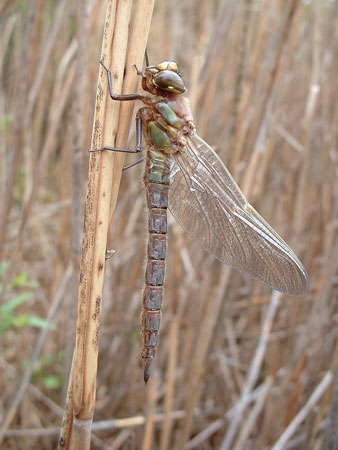 ©Steve Stroud
The sighting by Kay and
Peter was not the first of 2004. Glyn Clarke pipped them
by a day finding Large Red Damselflies Pyrrhosoma
nymphula on the Avon at Barford and
Stratford on Saturday 24th April. Specimens also emerged
from our garden pond on the 26th and 27th April. The cold wet
weather since has slowed things down. April
25th 2004
It is the end of 2003 and time to send any records you have for the year to the coordinator. Records are always welcome and will be incorporated into the Warwickshire dragonfly atlas. Please supply them in the form requested, see the Recording information page. We are particularly interested to have records of Common Hawker Aeshna juncea. We spent a lot of time in August and September looking for them at possible sites in the North of the county. They are definitely uncommon in Warwickshire and, perhaps, should be called the Uncommon (Warwickshire) Hawker! If you do send in a record be ready for, but not inhibited by, a request for more information to confirm the identification. They can be tricky to separate from the Migrant Hawker Aeshna mixta unless you are familiar with both species. If you have one, a photograph can be very helpful in confirming identity. Even better, if you have an exuvia you think may be a Common Hawker we will be very happy to check its identity. Since first writing this paragraph the Warwickshire branch of Butterfly Conservation have sent in a very interesting set of records collected during 2003 while making their transects. Included are records for Common Hawker at ten sites. Most of the sites are in the north of the county at or near sites likely to have acid water bodies - the favoured breeding habitat for the species. Also, some of the records are from quite early in the season, end of June/beginning of July, reducing the chance of mis-identifying Migrant Hawker (but what about Hairy Dragonfly!). There is some doubt about the identifications but they are very tantalising and we hope the presence of the species will be confirmed at these sites in 2004. An interesting observation we made on a visit
to Sutton Park on 15th September, during our fruitless Common Hawker
hunt, was
of a very bright and fresh looking copulating pair of Red-eyed damselfly Erythromma
najas.
We debated whether they were late emergences or survivors. Look at the Meetings and activities page for detail of the indoor meeting. Back to page top.A large emergence of Ruddy darter Sympetrum sanguineum at Toft near Dunchurch. More than 50 individuals emerging from the one pond. Also Beautiful demoiselle Calopteryx virgo. and Banded demoiselle Calopteryx splendens. together with White-legged damselfly Platycnemis pennipes on the Leam near by. Back to page top.Two Southern hawker Aeshna cyanea emerged from our garden pond today. Both males. Back to page top.The Brandon Marsh identification workshop was well attended by 27 participants. After an indoor session with Roy Ledbury and Kay and Peter Reeve we went out onto the reserve. During the day we found nine species to test our identification skills on. By the end of the day all of us could tell Azure from Common Blue Damselfly and Blue-tailed from Red-eyed Damselfly. A very successful day! Back to page top.Several Hairy Dragonfly Brachytron pratense adult males displaying breeding behaviour at Stockton and Peter's first mature male Emperor dragonfly Anax imperator flying its beat too. Plenty of Four-spotted chaser Libellula quadrimaculata breeding activity and emerging Black-tailed skimmer Orthetrum cancellatum. A visit to Wormleighton Reservoir produced
masses of Red-eyed damselfly Erythromma
najas and
Common Blue Damselflies
Enallagma cyathigerum in cop. and ovipositing. There
were
very large numbers of maturing White-legged damselfly Platycnemis
pennipes. Many of these probably from the Oxford Canal
which runs beside the reservoir. An early record for two teneral Common darter Sympetrum striolatum by Glyn Clarke in the SW of the county. Kay and Peter Reeve found an exuvia for Emperor dragonfly Anax imperator at Lighthorne Heath. So the big ones are flying in the county now! Also a new site and first 2003 Warwickshire record for the Beautiful demoiselle Calopteryx virgo. on Theslford Brook close to Lighthorne village. Back to page top.At
the Brandon Marsh Bird Fair Kay and Peter Reeve led dragonfly ID walks
on both days. Plenty of Broad-bodied
chaser
Libellula depressa and Red-eyed damselfly Erythromma
najas
about plus Four-spotted
chaser Libellula quadrimaculata and the expected
damselflies:
Large Red, Azure, Common Blue, Blue-tailed
and Banded Demoiselles. Glyn
Clarke has been at work again. He now has the first 2003 record Black-tailed skimmer Orthetrum
cancellatum for the county. Glyn
Clarke found the Scarce
Blue-tailed damselfly Ischnura pumilio . Three males
were seen in the same
place as last year. Very good news! Glyn
also found Four-spotted
chaser Libellula quadrimaculata at Lighthorne Heath.
First Warwickshire record for the species this year? Do not be too trusting in the weather forecasts! In spite of indifferent predictions the BDS/Warwickshire Dragonfly Group visit to Woodwalton Fen proved an exceptional success. The more than twenty of us there had timed it perfectly for the Scarce Chaser. Over the Fen there must have been hundreds of freshly emerged individuals. The photographers were very busy recording the highly co-operative animals. A preview by Kay and Peter Reeve the previous afternoon had been very auspicious one with between 30 and 40 Scarce Chasers seen roosting low on vegetation well into the evening (7-30pm). This contrasted with Saturday evening when by 6-00pm none were to be seen – presumably they had gone off to roost more securely in the trees. Also
present were emerging and immature Four-spotted Chasers,
an immature Broad-bodied Chaser. The Hairy Dragonfly
was in breeding mode with several males holding territory and at least
one female observed ovipositing. Large Red Damselflies were
present and in cop, tandem and ovipositing along with newly emerged and
mature territory holding male Red-eyed Damselflies. There were
masses of Azure and good numbers of Common Blue and Blue-tailed
damselflies to completed the tally for a memorable day. An exuvia hunt
was not very productive but Steve Stroud found a Scarce Chaser
exuvia and a Hairy Dragonfly exuvia was found too. Finally, a
thank you to Alan Bowley of English Nature for leading us in the
morning. The
Hairy Dragonfly Brachytron
pratense season is well under way. Kay and I found three
pre-flight emergent females and ten exuvia at Stockton. A visit with
Steve Stroud to the Avon at Marlcliff and Welford on Avon yielded a
couple of immature Club-tailed
Dragonfly Gomphus vulgatissimus and an exuvia plus an Azure Damselfly Coenagrion
puella. May 14th 2003 A
visit to the Avon near Welford on Avon yielded results. Kay found one
exuvia of
Club-tailed Dragonfly Gomphus
vulgatissimus male just below the weir, very close to where we
found one last year. Surely it must be higher up the Avon? If you can,
look for exuvia between Welford and Stratford. There are plenty of
public footpaths giving access. Also Banded
demoiselle Calopteryx splendens and a few Blue-tailed damselfly Ischnura
elegans were in evidence at Welford and Luddington. Two
pre-flight emergents Banded
demoiselle Calopteryx splendens and their exuvia were
found at Welford. Glyn
Clarke has been at work again. The first record for Club-tailed Dragonfly Gomphus
vulgatissimus in the county (and the country?) for 2003. Two
pre-flight emergents, one each male and female, plus a further exuvia
all at Marlcliff near Bidford on Avon. He also saw several Banded demoiselle Calopteryx
splendens here and quite a lot on the Avon at Wasperton,
Barford
and Stratford. He also reports Blue-tailed
damselfly Ischnura elegans and Large Red Damselflies Pyrrhosoma
nymphula at these sites.
The
exuvia
of a female Hairy
Dragonfly Brachytron pratense found by Kay at Stockton.
Look out now for this species elsewhere in the county. Also two teneral
Common Blue Damselflies
Enallagma cyathigerum where seen. Lots of Large Red Damselflies Pyrrhosoma
nymphula are now emerging. April 22nd 2003 Thank you to the recorders who supplied details of their sightings for 2002. They have now been entered into the Darter database and the distribution maps on the web site have been updated. The records for 2001 and 2002 are identified on the Atlas maps. It was very helpful that most records were supplied in the form requested, see the recording information page. Three
Group activities are planned for this year. A visit to Woodwalton Fen
in May and an adult identification workshop in June. Details of the
third meeting are yet to be finalised. See the meetings
and activities page for details. The weather improved just in time for the field meeting at Kingsbury Water Park on Saturday 13th July. A group of twenty keen dragonfly enthusiast assembled at Broomy Croft ready for a good day and set off at 10-30. We did a figure-of-eight and visited about a dozen or so pools, the River Tame and the Birmingham & Fazeley Canal. The quality of the pools varied from excellent with very good vegetation to poor heavily algae infested pools. The damselflies and dragonflies were slow in showing activity, probably a consequence of the preceding relatively cold night, but by the time we sat down to our lunch at midday by one of the best pools they were performing well though in fairly small numbers. We did not quite make the dozen species mark. The eleven seen were: Banded Demoiselle Calopteryx splendens, Emerald Damselfly Lestes sponsa, Azure Damselfly Coenagrion puella, Common Blue Damselfly Enallagma cyathigerum, Blue-tailed Damselfly Ischnura elegans, Red-eyed Damselfly Erythromma najas, Brown Hawker Aeshna grandis, Emperor Dragonfly Anax imperator, Four-spotted Chaser Libellula quadrimaculata, Broad-bodied Chaser L. depressa, Black-tailed Skimmer Orthetrum cancellatum. Four exuvia of the Brown Hawker were found too. The hoped for White-legged Damselfly was not seen and the absence of any sighting of Darters was surprising. The
Atlas
distribution maps have been updated with these records and others
received
to Monday 15th July. Wednesday 3rd July 2002 Records for Warwickshire for 2002 continue to come in - from a few individuals. The season is now well under way and the first sighting of the species of high summer are being made. The first Common Darter Sympetrum striolatum on 4th June and Emerald Damselfly Lestes sponsa on 16th June by Glyn (GC), Ruddy Darter Sympetrum sanguineum on 24 June by Kay Reeve and Brown Hawker Aeshna grandis on 30th June by Kay and Peter. The
Atlas
distribution maps are all updated to 1st July. The range of White-legged damselfly Platycnemis
pennipes is being nicely extended. Have you seen any in those
blank spaces? If so please let me know. The Group field meeting at Otmoor was very well attended by about 25 dragonfly enthusiasts. We started with a brief history of the reserve from the RSPB warden Neil Lambert. He then lead us off into the reserve on a warm but blustery day to see what we could find. The dragonflies and damselflies must have been keeping their heads down because of the high winds. In spite of this we saw 9 species but mostly in small numbers. In some sheltered spots there were large numbers of damselflies. The species seen were: Large Red Damselfly Pyrrhosoma nymphula, Azure Damselfly Coenagrion puella, Common Blue Damselfly Enallagma cyathigerum, Blue-tailed Damselfly Ischnura elegans, Red-eyed Damselfly Erythromma najas, Emperor Dragonfly Anax imperator, Four-spotted Chaser Libellula quadrimaculata, Black-tailed Skimmer Orthetrum cancellatum, Common Darter Sympetrum striolatum. We also found a few exuvia of Black-tailed Skimmer and Emperor Dragonfly. Sadly,
the Hairy Dragonfly seen here earlier in the month was not evident.
Also we were unable to find the White-legged Damselfly or Banded
Demoiselle, two species Neil is hoping to find on the River Ray which
flows through the reserve. The river looks right for both species. Even
so, the day was enjoyed by all who attended. Thanks to Neil and the
RSPB. Visits to Cryfield Grange Pool, Kenilworth (SP299749) yielded an early Black-tailed Skimmer Orthetrum cancellatum & several Red-eyed Damselfly Erythromma najas (GC) and an Emperor Anax imperator exuiva (PJR). It had been washed off its emergence site by the rain into the water. One hopes the emergee survived. These are the first county records for the species in 2002 notified so far. More
good records from Glyn (GC) extending the known distribution of the White-legged damselfly Platycnemis
pennipes in the county. He recorded it on the
Stratford-upon-Avon canal at Preston Bagot (adjacent to a tributary of
the Alne, SP172649)
and at Barford on the Avon (SP265610). Saturday 1st and Tuesday 4th June 2002 Amazing
days! The first reliable records for Scarce Blue-tailed damselfly Ischnura
pumilio in the county of Warwickshire were made. The first
individual, a male, was spotted by Glyn Clarke (GC) on the 1st June.
(Glyn is having a remarkably good first season as a dragonfly recorder.
Let us hope his
luck continues!) A follow up visit on 4th June yielded three males and
an aurantica phase female. They were found by very shallow
pools
with fairly sparse, open emergent vegetation. In one case, a water
filled
wheel rut. The site is private and its location must remain secret. An
adult female Hairy
Dragonflies Brachytron pratense spotted at Cryfield Grange
Pool, Kenilworth (SP299749) by Glyn Clarke. It is a new location for
the species. Is it breeding there? Once again Glyn Clarke has been active and sighted a Club-tailed Dragonfly Gomphus vulgatissimus , many Banded Demoiselle Calopteryx splendens and a Broad-bodied Chaser Libellula depressa on the Arrow near Broom (SP085528). Kay
and
Peter Reeve visited the River Blythe near Hampton-in-Arden. There were
lots
Banded Demoiselle Calopteryx
splendens and a number of Beautiful Demoiselle Calopteryx
virgo at two sites, near Marsh house Farm (SP215796) &
Barston (SP202779). A visit to the Leam at Wolfhamcote, a site that has
a strong population of Beautiful Demoiselles, on Thursday 16th yielded
none. A
female Broad-bodied Chaser Libellula
depressa emerged from our garden pond today. Kay and Peter Reeve visited the Avon today looking for Club-tailed Dragonflies Gomphus vulgatissimus . At Marlcliff (SP093505) about 10 adults were seen, mostly newly emerged. Sixteen exuvia, 5 male & 11 female were collected. Three kilometres upstream, opposite West Hillborough (SP123517), an emerging female was found. One or two have been seen flying here previous years but this is the first proof of breeding. Five exuvia were collected, 1 male & 4 female. A further three kilometres upstream at Welford (SP140513) a single female exuvia was found. This is the furthest up the Avon it has been recorded breeding - so far. Also one immature White-legged Damselfly Platycnemis pennipes female was seen at Marlcliff, so they are on the wing. There
were lots of Banded
Demoiselle Calopteryx splendens at all three sites. More finds by Glyn Clarke at Marlcliff. Three Club-tailed Dragonflies Gomphus vulgatissimus , two females and one male. A female was seen emerging and two exuvia collected. There are now good numbers of Banded Demoiselle Calopteryx splendens there too, circa 50. Glyn also found Banded Demoiselles on the River Arrow near Arrow (SP082558). A Red-eyed Damselfly Erythromma
najas seen at Wormleighton Reservoir by Peter Reeve. Two pre-flight emergent Hairy Dragonflies Brachytron pratense , females, where seen at Stockton by Kay and Peter Reeve. A further five exuvia were found. In total, five female and four male. Also an emerging Four-spotted Chaser Libellula quadrimaculata . A visit later in the day to the Dragonfly Ponds at Brandon Marsh produced good numbers of immature Azure Damselfly Coenagrion puella and Blue-tailed Damselfly Ischnura elegans . It
is time to start look for the Hairy Dragonfly at other suitable sites.
They like ponds and lakes with good, mature stands of emergent bank
side vegetation, Typha, Common Club-rush, Common Reed. They require a
lot of decaying vegetable matter at in the water. It is used by the
females to lay their eggs and by the larvae for support and hiding. Four
males and one female Banded
Demoiselle Calopteryx splendens were seen by Glyn Clarke at
the Avon, Marlcliff (SP093505). This is a very early record for
Warwickshire. The only earlier one in the archive is for 29th April
1950 and the next 15th May 1998. Also a Large Red Damselfly was seen. Peter
Reeve sighted a single female Large Red Damselfly at Stockton. The
season is definitely under way. Follow the link Large Red Damselfly Pyrrhosoma
nymphula for the new distribution map. Kay
Reeve
saw two Large Red Damselflies at Brandon Marsh. The first of the 2002
season
for Warwickshire? Sunday 14th April 2002 - Larval identification workshop Seven of us had a very interesting day learning and testing our abilities to identify dragonflies from exuvia and larvae. We were particularly lucky to have Steve Cham present to provide guidance. Many thanks to Steve for coming. The morning was spent in the laboratory. First we had a slide presentation illustrating the features used to identify exuvia and larvae. This was followed by a practical session trying our skills on a set of exuvia. After
lunch we went out on to the Brandon Marsh Reserve, dipping, to see what
live larvae we could find. Success was limited, it was still fairly
cold. We found and identified Emperor Anax imperator, Southern
Hawker Aeshna cyanea and Red-eyed Damselfly Erythromma najas.
We also found a number of Coenagrionid larvae and all concluded
identification of adults is easier! Thank you to the recorders who supplied details of their sightings for 2001. They have now been entered into the Darter database and the distribution maps on the web site have been updated. The records for 2001 are identified on the Atlas maps. It was very helpful that most records were supplied in the form requested, see the recording information page. Three Group activities are
planned for
this year. A larvae identification workshop in April and two fields
meetings:
a visit to the RSPB Otmoor reserve in June and the Kingsbury Water Park
in July. See the meetings and activities
page
for details.
The day of the Group visit to Cannock Chase dawned and the weather forecast was not auspicious, rain was predicted for the late morning. We arrived at the meeting place and by 11-30am a group of 17 eager odonatists, some from Warwickshire others from the wider BDS, was ready to visit the first pool, Womere (Ref. SJ980178). In spite of only very weak sun shining through the high thin cloud of the approaching front we sighted our first Black Darter Sympetrum danae, a female, even before we reached the pool. Shortly afterwards a male Common Hawker Aeshna juncea was spotted on the pond holding territory. The two target species were found within ten minutes of leaving the car park! For the next two hours the group spread out round the pond some observing and some photographing the many Black Darters and Common Hawkers present. Activity waxed and waned as the the strength of the sun did. Breeding activity by both target species was observed and one observant member of the group found the exuvia of a female Common Hawker (thank you Ted). Other species seen were: a few individuals of Brown and Southern Hawkers Aeshna grandis & A. cyanea, a number of Common Darter Sympetrum striolatum, just two male Azure Damselflies Ceonagrion puella and good numbers of the Emerald Damselfly Lestes sponsa. There was much breeding activity by this last species. It was noticed the abdomens several female Emerald Damselflies were covered with a thin whitish deposit. Mud or algae? No doubt it was acquired during oviposition. Rather more surprising was the male Common Hawker with the same deposit covering its abdomen. After lunch we moved to a second area, the Long Mere ponds (Ref SJ974207) and set out to them in a sharp downpour. This quickly stopped and we were rewarded by finding some new species. However, the find of the afternoon was made by Rosemary Shah who spotted a pair of Common Hawkers in the wheel position on a gorse bush. Their wing were covered in drops of rain. Needless to say there was a scrum of photographers round the pair. After some minutes the pair broke up and the female flew away leaving the male which flew after a further few minutes. The additional species seen at Long Mere were: a single male Four-spotted Chaser Libellula quadrimaculata, a male Ruddy Darter Sympetrum sanguineum and single individuals of Common Blue and Common Blue-tailed damselflies Enallagma cyathigerum & Ischnura elegans. It was a very successful meeting with eleven species seen made even more enjoyable because the predicted rainy weather did not start in earnest until after we left the field for the Tea Shop! 30th June 2001 The Adult Identification Workshop at Brandon Marsh on 23rd June was very successful with 28 participants of widely varying expertise. An intense indoor session going through the species present or expected in Warwickshire was followed by two sessions out on the reserve looking at the actual insects. (Thanks to Kay Reeve and Roy Ledbury for the excellent slides illustrating the species.) It was a warm and humid day will sunny intervals. Dragonflies were not present in large numbers but eleven species were seen providing useful experience for the beginners in separating the more common species. The species seen were: Banded Demoiselle Calopteryx splendens, Large Red Damselfly Pyrrhosoma nymphula, Azure Damselfly Coenagrion puella, Common Blue Damselfly Enallagma cyathigerum, Blue-tailed Damselfly Ischnura elegans, Red-eyed Damselfly Erythromma najas, Emperor Anax imperator, Four-spotted Chaser Libellula quadrimaculata, Broad-bodied Chaser L. depressa, Black-tailed Skimmer Orthetrum cancellatum and an immature Common Darter Sympetrum striolatum. A visit the next day, 24th June, to the second known Warwickshire site for the Hairy Dragonfly Brachytron pratense confirmed its presence there again this year. Unfortunately it was not possible to gain access to the site as early as hoped this year so the opportunity to find exuvia was missed.
Sixteen dragonfly enthusiasts met at Alvecote Pooley Fields on the 3rd June for a very successful meeting. It was a day of bright sun with a cool NW breeze. Ten species were seen including at least a dozen male and two female Hairy Dragonflies Brachytron pratense. The other species seen were: Banded Demoiselle Calopteryx splendens, White-legged Damselfly Platycnemis pennipes, Large Red Damselfly Pyrrhosoma nymphula, Azure Damselfly Coenagrion puella, Common Blue Damselfly Enallagma cyathigerum, Blue-tailed Damselfly Ischnura elegans, Red-eyed Damselfly Erythromma najas, Four-spotted Chaser Libellula quadrimaculata, Broad-bodied Chaser L. depressa. Black-tailed Skimmer Orthetrum cancellatum has been seen at several sites, the first record for the year so far is for 4th June. On the 5th June an Emperor Dragonfly Anax imperator was seen holding territory over the River Leam at Eathorpe. A visit on a warm but fairly cloudy 12th June to Marlcliff on the River Avon confirmed the presense of the Club-tailed Dragonfly Gomphus vulgatissimus again this year. 27th May 2001 Large Red Damselflies Pyrrhosoma nymphula have been about now from the beginning of May. We first saw them emerge from our pond at Leamington Hastings on 5th May. By the 15th May they were mature and breeding was in full swing. On 12th May the first Broad-bodied Chaser Libellula depressa was spotted perched on a shrub in the garden sunning itself. A week later the first male was holding territory on the garden pond. It joined the Large Red and Azure Damselflies Coenagrion puella that were busy with breeding and egg laying. A visit to Alvecote Pooley Fields on 19th May (now open after being closed as a Foot and Mouth Disease precaution) in coolish cloudy conditions showed the emergence of the Red-eyed Damselfly Erythromma najas well under way with many immature specimens about. 26 th February 2001 The Group indoor meeting for 2001 was held at the Warwickshire Wildlife Trust, Brandon Nature Centre on 15th February. The main event of the evening was an excellent presentation by Roy Ledbury supported by his beautiful natural history photographic slides including, of course, many of dragonflies and damselflies. Of particular note was a series of slides showing the variations of the more common blue damselflies together with an authoritative description by Roy on how to use the features to separate males and females of the species in the field.
Peter
Reeve, Co-ordinator WDG
|
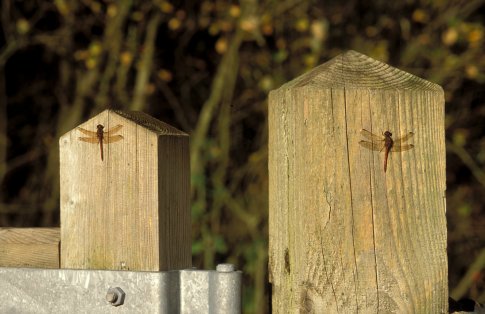 As the table of
records shows, the latest date for both Migrant
Hawker and Common Darter in the county records have moved on by 10 days.
As the table of
records shows, the latest date for both Migrant
Hawker and Common Darter in the county records have moved on by 10 days.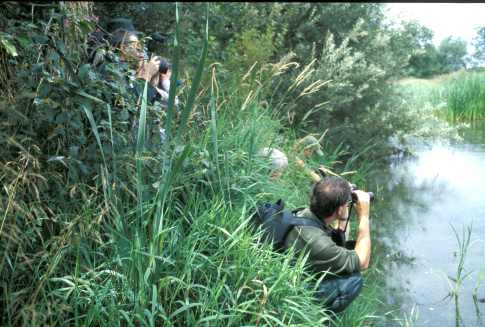 In the afternoon we went to the Swift Valley Reserve at
Rugby and
the weather continued to improve with lengthy sunny intervals. We were
encouraged by two or three Migrant Hawkers feeding by the car park as
we set off for the pool. Red-eyed Damselflies were quickly spotted but
they were too far out to positively identify. More searching and some
were found closer to the bank and, yes, they were Small Red-eyes!
The photo' shows some of the group trying to get the best view
possible. The
weather continued to improve and a total of fifteen or more individuals
and three or four ovipositing pairs were found. Other species seen were
a male Emperor, half a dozen each Brown and Southern Hawkers as well as
Common Darter and Common Blue and Blue-tailed Damselflies and three or
four Large Red-eyes. One sharp eyed observer spotted and recovered a
Migrant Hawker exuvia.
In the afternoon we went to the Swift Valley Reserve at
Rugby and
the weather continued to improve with lengthy sunny intervals. We were
encouraged by two or three Migrant Hawkers feeding by the car park as
we set off for the pool. Red-eyed Damselflies were quickly spotted but
they were too far out to positively identify. More searching and some
were found closer to the bank and, yes, they were Small Red-eyes!
The photo' shows some of the group trying to get the best view
possible. The
weather continued to improve and a total of fifteen or more individuals
and three or four ovipositing pairs were found. Other species seen were
a male Emperor, half a dozen each Brown and Southern Hawkers as well as
Common Darter and Common Blue and Blue-tailed Damselflies and three or
four Large Red-eyes. One sharp eyed observer spotted and recovered a
Migrant Hawker exuvia.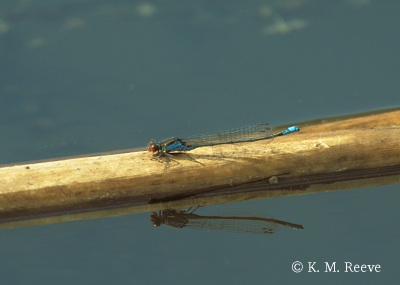 Yes they are at
Swift Valley again this year. A visit on a warm sunny day yielded both
Red-eyes. There were not many
Yes they are at
Swift Valley again this year. A visit on a warm sunny day yielded both
Red-eyes. There were not many 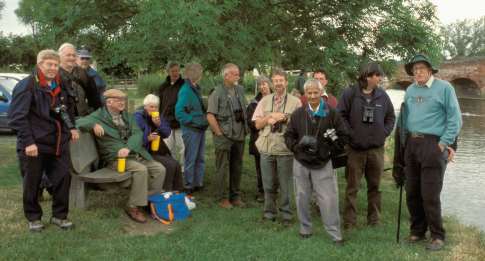 Following the ID
workshop on this busy weekend we had a joint meeting
with the Worcestershire Group on the Avon at Eckington. The target was
Worcestershire's latest
addition, the Scarce Chaser, and with Club-tailed Dragonfly as a bonus.
A group of twenty-five enthusiasts assembled from Warwickshire,
Worcestershire and other
counties and countries (two from Wales). The
photo' shows that part of the group that could be organised to stand
for the snap.
Following the ID
workshop on this busy weekend we had a joint meeting
with the Worcestershire Group on the Avon at Eckington. The target was
Worcestershire's latest
addition, the Scarce Chaser, and with Club-tailed Dragonfly as a bonus.
A group of twenty-five enthusiasts assembled from Warwickshire,
Worcestershire and other
counties and countries (two from Wales). The
photo' shows that part of the group that could be organised to stand
for the snap.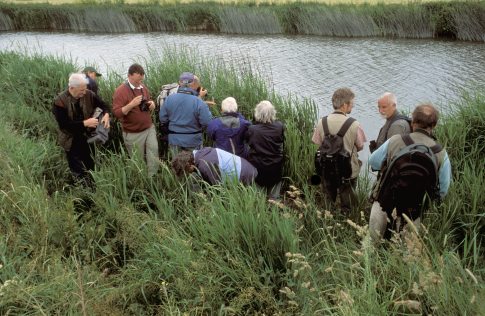
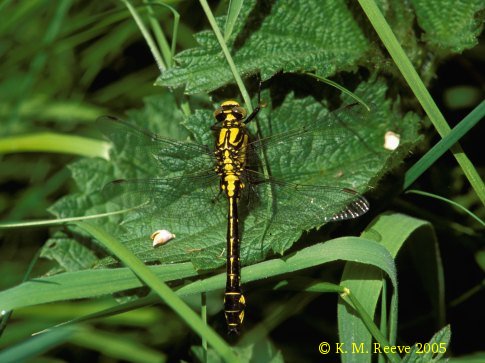 A visit was made to
the Avon at Marlcliff seeking the
A visit was made to
the Avon at Marlcliff seeking the 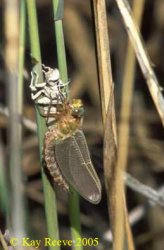 A
good day today. Kay
and Peter Reeve found their first
A
good day today. Kay
and Peter Reeve found their first 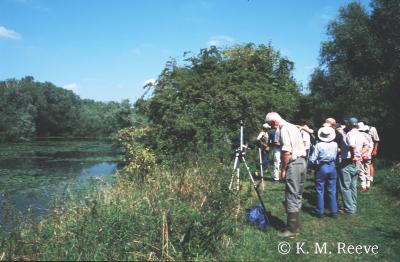 Eighteen members of
the
Warwickshire Dragonfly Group plus a BDS member each from Northampton
and Leicestershire arrived at Priory Country Park, Bedford on a bright
sunlit morning were we were met by Steve Cham. The object was to see
and learn about the Small Red-eyed Damselfly which is rapidly
colonizing the country and was expected very soon in Warwickshire.
Steve lead us off to Finger Lake and we were very soon watching and
photographing males of the target species. Steve gave us very good
instruction on their identification, the presence of Large(?) Red-eye
allowing good comparison. Later in the morning the males were joined by
females and we observed their breeding behaviour. In the afternoon we
moved on to Wrest Park where, to the great satisfaction of the
photographers, even closer views of Small Red-eyed Damselfly were
obtained . After Steve's excellent tuition we left with
some confidence we could identify Small Red-eye when it arrived in
Warwickshire.
Eighteen members of
the
Warwickshire Dragonfly Group plus a BDS member each from Northampton
and Leicestershire arrived at Priory Country Park, Bedford on a bright
sunlit morning were we were met by Steve Cham. The object was to see
and learn about the Small Red-eyed Damselfly which is rapidly
colonizing the country and was expected very soon in Warwickshire.
Steve lead us off to Finger Lake and we were very soon watching and
photographing males of the target species. Steve gave us very good
instruction on their identification, the presence of Large(?) Red-eye
allowing good comparison. Later in the morning the males were joined by
females and we observed their breeding behaviour. In the afternoon we
moved on to Wrest Park where, to the great satisfaction of the
photographers, even closer views of Small Red-eyed Damselfly were
obtained . After Steve's excellent tuition we left with
some confidence we could identify Small Red-eye when it arrived in
Warwickshire.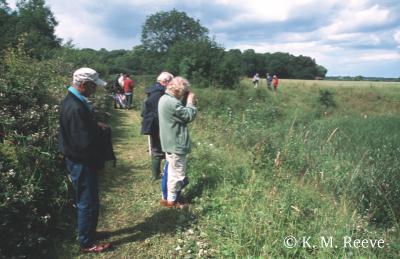 This was a special
meeting to
visit a private reserve by kind permission of the owner Jim Russell. On
his farm he has created a number of pools of varying character that are
attractive to dragonflies. The upper reaches of the River Leam also run
through the farm.
This was a special
meeting to
visit a private reserve by kind permission of the owner Jim Russell. On
his farm he has created a number of pools of varying character that are
attractive to dragonflies. The upper reaches of the River Leam also run
through the farm.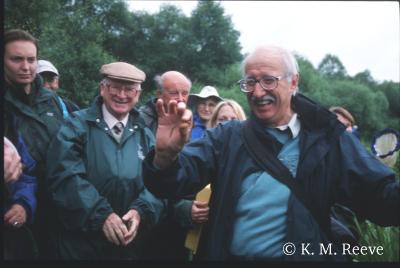 The Warwickshire
Dragonfly
Group workshop was held this year was at Sutton Park National Nature
Reserve. This is a unique site, a mosaic of heathland, woodland and
wetland, with pools, and located within the West Midland conurbation.
In spite of the dull and at times wet weather more than twenty
participants turned up. The indoor session was necessarily extended
with presentations by Roy Ledbury, Kay and Peter Reeve and David
Goddard. We did get out into the Park and visit Little Bracebridge
Pool, perhaps the best dragonfly pond in the Park. Though the weather
was very poor we found five species plus one exuvia to test our
identification skills.
The Warwickshire
Dragonfly
Group workshop was held this year was at Sutton Park National Nature
Reserve. This is a unique site, a mosaic of heathland, woodland and
wetland, with pools, and located within the West Midland conurbation.
In spite of the dull and at times wet weather more than twenty
participants turned up. The indoor session was necessarily extended
with presentations by Roy Ledbury, Kay and Peter Reeve and David
Goddard. We did get out into the Park and visit Little Bracebridge
Pool, perhaps the best dragonfly pond in the Park. Though the weather
was very poor we found five species plus one exuvia to test our
identification skills.